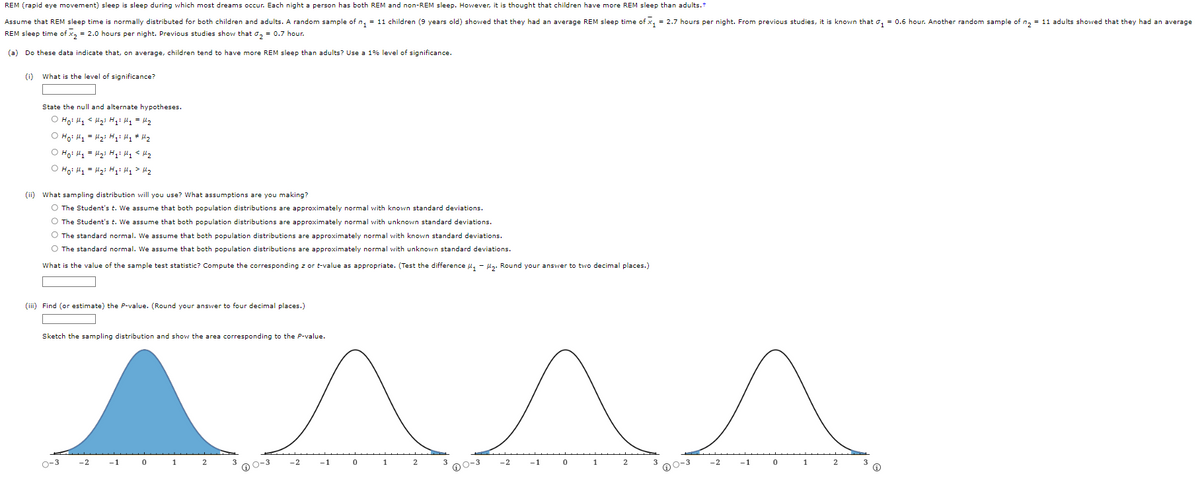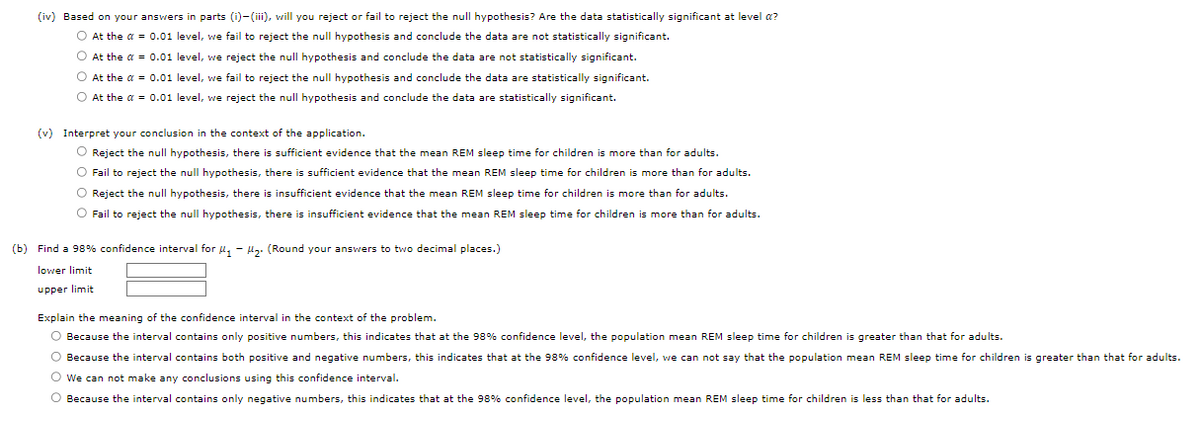on average, children and have more REM sleep than adults? Use 1% level of significance. nificance? mate hypotheses. tion will you use? What assumptions are you making? Ve assume that both population distributions are approximately normal with known standard deviations. Ve assume that both population distributions are approximately normal with unknown standard deviations. mal. We assume that both population distributions are approximately normal with known standard deviations.
on average, children and have more REM sleep than adults? Use 1% level of significance. nificance? mate hypotheses. tion will you use? What assumptions are you making? Ve assume that both population distributions are approximately normal with known standard deviations. Ve assume that both population distributions are approximately normal with unknown standard deviations. mal. We assume that both population distributions are approximately normal with known standard deviations.
Holt Mcdougal Larson Pre-algebra: Student Edition 2012
1st Edition
ISBN:9780547587776
Author:HOLT MCDOUGAL
Publisher:HOLT MCDOUGAL
Chapter11: Data Analysis And Probability
Section: Chapter Questions
Problem 8CR
Related questions
Question

Transcribed Image Text:REM (rapid eye movement) sleep is sleep during which most dreams occur. Each night a person has both REM and non-REM sleep. However, it is thought that children have more REM sleep than adults.+
Assume that REM sleep time is normally distributed for both children and adults. A random sample of n₁ = 11 children (9 years old) showed that they had an average REM sleep time of x₁ = 2.7 hours per night. From previous studies, it is known that ₁ = 0.6 hour. Another random sample of n₂ = 11 adults showed that they had an average
REM sleep time of x₂ = 2.0 hours per night. Previous studies show that σ₂ = 0.7 hour.
(a) Do these data indicate that, on average, children tend to have more REM sleep than adults? Use a 1% level of significance.
(0) What is the level of significance?
State the null and alternate hypotheses.
O Hoi Hy <H₂i H₁ H₂ = H₂
O Ho: M₁ = M₂³ H₁² H₁ # H₂
O Ho H₁
H₂ H ₂: My <H₂
Hoi H₁
H₂i Hqi Hy > M₂
(ii) What sampling distribution will you use? What assumptions are you making?
O The Student's t. We assume that both population distributions are approximately normal with known standard deviations.
O The Student's t. We assume that both population distributions are approximately normal with unknown standard deviations.
O The standard normal. We assume that both population distributions are approximately normal with known standard deviations.
O The standard normal. We assume that both population distributions are approximately normal with unknown standard deviations.
What is the value of the sample test statistic? Compute the corresponding z or t-value as appropriate. (Test the difference ₁-₂. Round your answer to two decimal places.)
(iii) Find (or stimate) the
Sketch the sampling distribution and show the area corresponding to the P-value.
0-3
-2
-1
Round your answer four decimal places.)
0
1
2
0-3
-2
-1
0
1
2
0-3
-2
-1
0
1
0-3
-2
-1
0
1
2
Ⓡ

Transcribed Image Text:(iv) Based on your answers in parts (i)-(iii), will you reject or fail to reject the null hypothesis? Are the data statistically significant at level a?
O At the a = 0.01 level, we fail to reject the null hypothesis and conclude the data are not statistically significant.
O At the a = 0.01 level, we reject the null hypothesis and conclude the data are not statistically significant.
O At the α = 0.01 level, we fail to reject the null hypothesis and conclude the data are statistically significant.
O At the a = 0.01 level, we reject the null hypothesis and conclude the data are statistically significant.
(v) Interpret your conclusion in the context of the application.
O Reject the null hypothesis, there is sufficient evidence that the mean REM sleep time for children is more than for adults.
O Fail to reject the null hypothesis, there is sufficient evidence that the mean REM sleep time for children is more than for adults.
O Reject the null hypothesis, there is insufficient evidence that the mean REM sleep time for children is more than for adults.
O Fail to reject the null hypothesis, there is insufficient evidence that the mean REM sleep time for children is more than for adults.
(b) Find a 98% confidence interval for ₁-₂. (Round your answers to two decimal places.)
lower limit
upper limit
Explain the meaning of the confidence interval in the context of the problem.
greater than that for adults.
O Because the interval contains only positive numbers, this indicates that at the 98% confidence level, the population mean REM sleep time for children
Because the interval contains both positive and negative numbers, this indicates that at the 98% confidence level, we can not say that the population mean REM sleep time for children
O We can not make any conclusions using this confidence interval.
O Because the interval contains only negative numbers, this indicates that at the 98% confidence level, the population mean REM sleep time for children is less than that for adults.
greater than that for adults.
Expert Solution
This question has been solved!
Explore an expertly crafted, step-by-step solution for a thorough understanding of key concepts.
Step by step
Solved in 3 steps with 5 images

Recommended textbooks for you

Holt Mcdougal Larson Pre-algebra: Student Edition…
Algebra
ISBN:
9780547587776
Author:
HOLT MCDOUGAL
Publisher:
HOLT MCDOUGAL

Holt Mcdougal Larson Pre-algebra: Student Edition…
Algebra
ISBN:
9780547587776
Author:
HOLT MCDOUGAL
Publisher:
HOLT MCDOUGAL